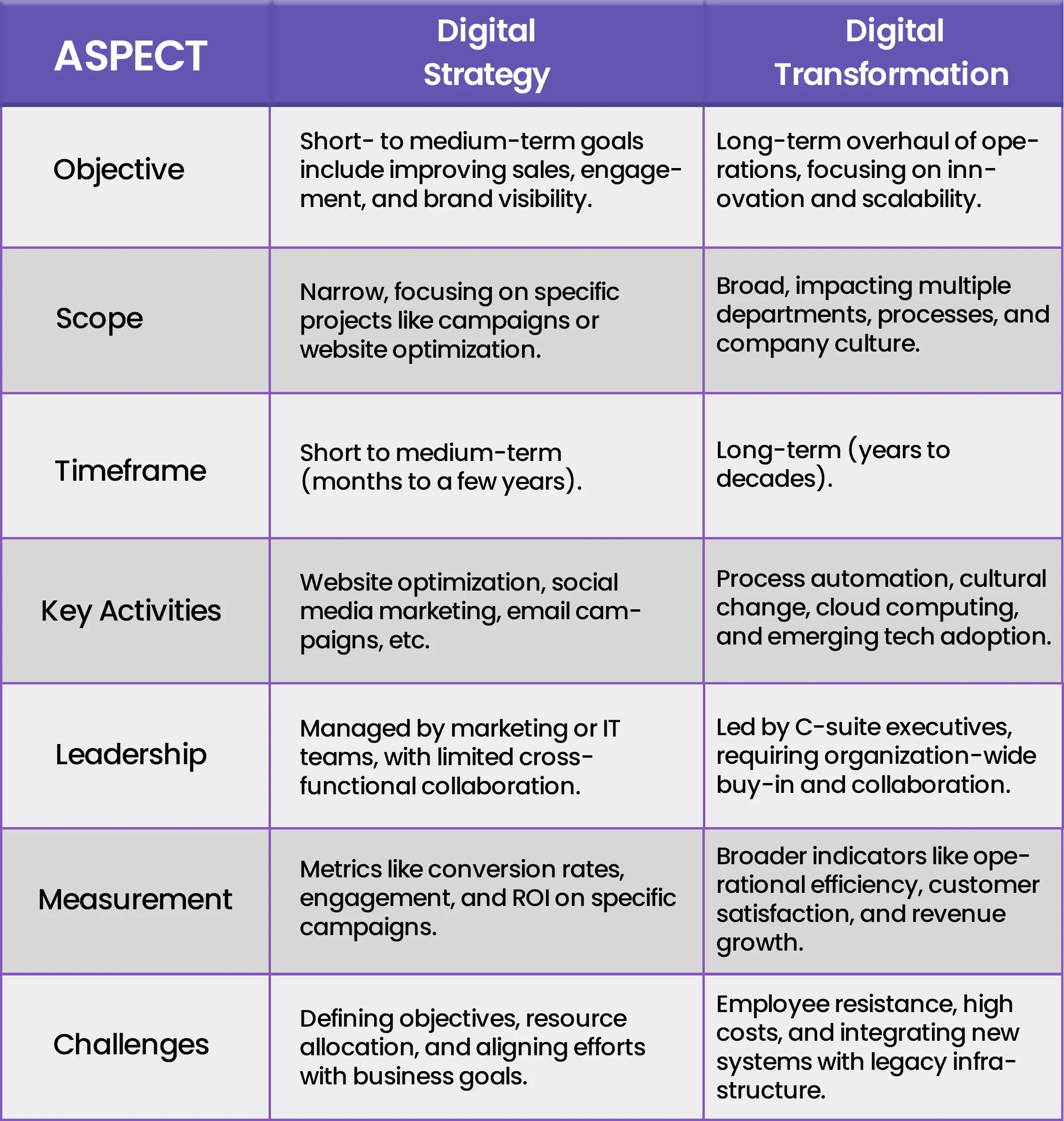We CEOs accept that a sound digital strategy plays a prominent role in our business success. And using the right tech and digital stack offers plenty of competitive and bottom-line benefits, including improved customer experience, streamlined operations, and more.
However, it’s no good when our digital strategies fail to align with our company’s broader objectives or fail to bring a grander change to the business through processes, people, and technology.
This brings us to the debate of digital strategy vs. digital transformation. In this blog, I’ll cover the basics of digital strategy and transformation, their connections and differences, and how to integrate both approaches for business growth.
Understanding Digital Strategy vs. Digital Transformation
Digital Strategy—A blueprint for business success
A digital strategy is a structured plan that CEOs and business leaders create detailing the technologies and tools needed to achieve business objectives. It serves as a blueprint for enhancing operational efficiency, improving customer engagement, and gaining a competitive edge by integrating digital elements into various aspects of business operations.
Your digital strategy plan will cover diverse business aspects, including digital marketing, customer experience, data analytics, and technology adoption. A strong strategy is your first step towards a digital-first approach. The plan enables organizations to utilize technology and adapt to market changes.
Besides the bottom-line benefits, a well-executed strategy at the core of your business operations encourages innovation and continuous improvement. The plan supports both long-term growth and digital transformation.
Digital Transformation—Revolutionizing business for the future
Digital transformation requires a fundamental shift in business processes, systems, and models to leverage digital capabilities. Initiatives adopt and implement digital technologies to create new offerings and even completely new business models. This transformation also demands a cultural shift from everyone on board, including internal and external stakeholders.
Businesses opt for digital transformation initiatives to improve efficiency, streamline operations, make data-driven decisions, and stay competitive in their marketplaces. The adoption and implementation also enhance customer experience by enabling personalized, on-demand services that boost satisfaction and loyalty.
The Link Between Strategy and Transformation
Simply picking a paid tech stack isn’t enough, but there’s more to the digital strategy vs. digital transformation debate. As a business owner, you need to see if it aligns with your business objectives and seamlessly integrates with your processes and people’s roles. This requires us to understand the concept of digitalization, a connection between strategy and transformation.
Digitalization integrates digital technologies into business operations, processes, and models to improve efficiency and engagement value and create new revenue opportunities for organizations. The idea is to drive a paradigm shift in how businesses operate.
Digitalization—the key to robust transformation
Digitalization bridges the gap between strategy and transformation by enabling businesses to shift from traditional models to technology-driven operations. It includes automating tasks for efficiency and accuracy, leveraging data for informed decisions and personalized experiences, integrating AI, IoT, and cloud computing, and enabling real-time data analysis. It is imperative for business owners to consider digitalization as part of a culture of continuous learning.
Digitalization for strategic planning
Smart companies pursue digitalization for strategic or long-term planning, starting by evaluating internal and external opportunities and risks, continuously improving strategies based on market shifts and feedback, and prioritizing investments that accelerate transformation.
Transforming business models with digitalization
Digitalization also helps leaders reshape business models across industries, enabling new collaborations and partnerships, enhanced product and service offerings through AI and cloud technologies, and more personalized and on-demand customer interactions.
Major Differences Between Strategy and Transformation
Download Our Guide: Generative AI for Business Leaders
Challenges
Both digital strategy and digital transformation have their fair share of challenges. It’s not always straightforward to define clear objectives and allocate resources, especially when the efforts are aligned with business goals and tasked with producing tangible results.
Digital transformation is a much more difficult prospect, and it faces more complex challenges, such as employee resistance to change, high implementation costs, and difficulties integrating new digital systems with legacy infrastructure. You must display a strong sense of leadership, a well-defined roadmap, and a commitment to continuous adaptation to overcome these challenges.
Handpicked content: Legacy vs. Modern: Transform Your Business with Application Modernization
How to Integrate Digital Strategy and Transformation
Having separate strategy and transformation roadmaps in a silo isn’t doing you any good; leaders must learn how to incorporate both collectively in their 2025 roadmap.
Create a unified vision
Align your short-term digital strategies with long-term transformation goals. Acquire leadership buy-in to establish top-down commitment and place team leaders for planned execution. A shared vision will prevent silos and ensures that digital initiatives contribute to your overall business growth.
Run an internal evaluation
Examine your existing digital infrastructure, processes, and workforce availability. Second, audit key tools like CRM systems, analytics platforms, and automation software. And third, engage employees across departments to locate inefficiencies and set benchmarks against industry standards.
Produce a comprehensive roadmap
Your milestones for both strategy and transformation could be, for instance, launching a targeted campaign while preparing for a cloud migration. Write down dependencies, i.e., a CRM upgrade may be required before implementing AI-driven personalization in your roadmap. Assign cross-functional teams for seamless execution, adopt a phased, manageable approach with pilot projects, and see transparency using dashboards and Gantt charts.
Invest in state-of-the-art tech stack
Leverage the right tech stack to streamline workflows. For example, AI platforms like Azure AI, IBM Watson, etc., enhance automation, cloud services like AWS and Google Cloud for scalability, and Salesforce, Zoho, and other CRM systems optimize customer interactions. Moreover, Slack, Trello, etc., can be used for project correspondences, Tableau and Power BI for analytics, and emerging technologies like IoT for further transformation assistance.
Monitor and measure performance
See KPIs like customer acquisition cost, ROI, operational efficiency, and automation rates to monitor the performance of your transformative efforts. These analytical insights can be further used to improve strategies, scale successful projects, and eliminate inefficiencies.
Align continuous improvement with strategic goals
Let’s not forget that continuous improvement is part of our ongoing journey for digital excellence, not a one-time attempt. Ask your teams to conduct quarterly reviews, track industry trends, and adapt strategies to evolving market demands. Build a culture where experimentation with new technologies is appreciated as an essence of the culture of innovation.
Final Words!
We conclude our discussion by understanding that digital strategy and digital transformation are not competing forces but approaches that complement each other to drive business success. A well-defined digital strategy lays the playground for immediate gains, while digital transformation sees long-term adaptability and innovation.
By integrating both, businesses can acquire a blueprint that aligns technology, people, and processes to thrive in competitive marketplaces. CEOs and business leaders must develop a culture of continuous improvement, invest in the right technologies, and ensure leadership buy-in to stay competitive in 2025 and beyond.
See More: How to Measure Delivery Excellence in Your Tech Partner











